 |
 |
Our enthusiastic and extremely knowledgeable perennials team is here to answer your questions and help you choose the best perennials for your situation. There’s always something in bloom for sun, shade, butterflies, birds or deer resistance as well as a variety of bulbs for your space.
Stroll through our time-tested favorites and introduce yourself to the newest varieties. We garden with perennials too; we love them and it shows!
|
168 found, showing page 4 of 12
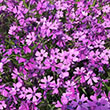
Fragrant purple blooms. Evergreen. Groundcover. Native. USDA 2-9
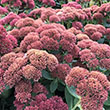
Height: 24 inches
Spacing: 18 inches
Sunlight: full sun, partial shade
Hardiness Zone: 2b
Other Names: Autumn Stonecrop, Showy Stonecrop
Description:
A highly desirable and popular groundcover, forming a dense mound completely covered in broccoli-like salmon-pink flowers which fade to red in early fall, succulent dusty-green foliage is prominent the rest of the season; needs a dry and sunny location
Ornamental Features:
Autumn Joy Stonecrop has masses of beautiful clusters of pink flowers at the ends of the stems from late summer to late fall, which emerge from distinctive coral-pink flower buds, and which are most effective when planted in groupings. The flowers are excellent for cutting. Its large succulent round leaves remain grayish green in color throughout the season.
Landscape Attributes:
Autumn Joy Stonecrop is a dense herbaceous perennial with an upright spreading habit of growth. Its relatively coarse texture can be used to stand it apart from other garden plants with finer foliage.
This is a relatively low maintenance plant, and is best cleaned up in early spring before it resumes active growth for the season. It is a good choice for attracting bees and butterflies to your yard, but is not particularly attractive to deer who tend to leave it alone in favor of tastier treats. It has no significant negative characteristics.
Autumn Joy Stonecrop is recommended for the following landscape applications:
- Mass Planting
- Border Edging
- General Garden Use
- Groundcover
- Container Planting
- Planting & Growing
Autumn Joy Stonecrop will grow to be about 20 inches tall at maturity, with a spread of 24 inches. When grown in masses or used as a bedding plant, individual plants should be spaced approximately 18 inches apart. It grows at a fast rate, and under ideal conditions can be expected to live for approximately 15 years. As an herbaceous perennial, this plant will usually die back to the crown each winter, and will regrow from the base each spring. Be careful not to disturb the crown in late winter when it may not be readily seen!
This plant does best in full sun to partial shade. It is very adaptable to both dry and moist growing conditions, but will not tolerate any standing water. It is considered to be drought-tolerant, and thus makes an ideal choice for a low-water garden or xeriscape application. It is not particular as to soil pH, but grows best in poor soils, and is able to handle environmental salt. It is highly tolerant of urban pollution and will even thrive in inner city environments. This particular variety is an interspecific hybrid. It can be propagated by division; however, as a cultivated variety, be aware that it may be subject to certain restrictions or prohibitions on propagation.
Autumn Joy Stonecrop is a fine choice for the garden, but it is also a good selection for planting in outdoor pots and containers. With its upright habit of growth, it is best suited for use as a 'thriller' in the 'spiller-thriller-filler' container combination; plant it near the center of the pot, surrounded by smaller plants and those that spill over the edges. Note that when growing plants in outdoor containers and baskets, they may require more frequent waterings than they would in the yard or garden.

Height: 30 inches
Spacing: 18 inches
Sunlight: full sun, partial shade
Hardiness Zone: 2b
Other Names: Showy Stonecrop
Description:
A very showy fall-blooming perennial with thick succulent leaves; an improvement on the popular Autumn Joy with a denser, more upright habit and deeper rose-pink flowers, highly effective in mass plantings or as a groundcover
Ornamental Features:
Autumn Fire Stonecrop has masses of beautiful clusters of rose flowers at the ends of the stems from late summer to late fall, which emerge from distinctive coral-pink flower buds, and which are most effective when planted in groupings. The flowers are excellent for cutting. Its large succulent round leaves remain grayish green in color throughout the season.
Landscape Attributes:
Autumn Fire Stonecrop is a dense herbaceous perennial with an upright spreading habit of growth. Its relatively coarse texture can be used to stand it apart from other garden plants with finer foliage.
This is a relatively low maintenance plant, and is best cleaned up in early spring before it resumes active growth for the season. It is a good choice for attracting bees and butterflies to your yard, but is not particularly attractive to deer who tend to leave it alone in favor of tastier treats. It has no significant negative characteristics.
Autumn Fire Stonecrop is recommended for the following landscape applications:
- Mass Planting
- General Garden Use
- Groundcover
- Container Planting
Planting & Growing:
Autumn Fire Stonecrop will grow to be about 24 inches tall at maturity, with a spread of 24 inches. When grown in masses or used as a bedding plant, individual plants should be spaced approximately 18 inches apart. It grows at a fast rate, and under ideal conditions can be expected to live for approximately 15 years. As an herbaceous perennial, this plant will usually die back to the crown each winter, and will regrow from the base each spring. Be careful not to disturb the crown in late winter when it may not be readily seen!
This plant does best in full sun to partial shade. It is very adaptable to both dry and moist growing conditions, but will not tolerate any standing water. It is considered to be drought-tolerant, and thus makes an ideal choice for a low-water garden or xeriscape application. It is not particular as to soil pH, but grows best in poor soils, and is able to handle environmental salt. It is highly tolerant of urban pollution and will even thrive in inner city environments. This is a selected variety of a species not originally from North America. It can be propagated by division; however, as a cultivated variety, be aware that it may be subject to certain restrictions or prohibitions on propagation.
Autumn Fire Stonecrop is a fine choice for the garden, but it is also a good selection for planting in outdoor pots and containers. With its upright habit of growth, it is best suited for use as a 'thriller' in the 'spiller-thriller-filler' container combination; plant it near the center of the pot, surrounded by smaller plants and those that spill over the edges. It is even sizeable enough that it can be grown alone in a suitable container. Note that when growing plants in outdoor containers and baskets, they may require more frequent waterings than they would in the yard or garden.
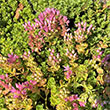
Pink blooms. Green foliage. Evergreen. Moderate foot traffic. USDA 3-8
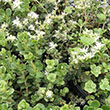
White blooms. Spreading succulent foliage. Native. USDA 4-8

Pink blooms. Lime green foliage with red margins. Creeping. USDA 4-9
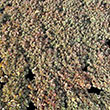
Pink blooms. Lime green foliage with red margins. Creeping. USDA 4-9

Vibrant blue blooms. Compact, clumping foliage. USDA 4-9
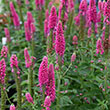
Bright pink blooms. Upright foliage. Clumping. USDA 4-8
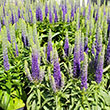
Deep blue-purple blooms. Upright compact foliage. USDA 3-8
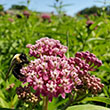
This monarch host plant produces pink blooms summer through fall. Requires moist soils. Self-seeder. Native. USDA 3-6
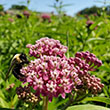
Plant Height: 3 feet
Flower Height: 4 feet
Spread: 32 inches
Sunlight: full sun partial shade
Hardiness Zone: 2a
Other Names: Butterfly Weed
Description:
A wonderful selection for attracting butterflies to garden beds and rain gardens; this upright selection features clusters of rosy-pink, fragrant flowers and green narrow foliage; a compact variety that is easy to grow, needing little to no maintenance
Ornamental Features:
Swamp Milkweed has fuchsia flat-top flowers with rose overtones at the ends of the stems from mid summer to early fall. The flowers are excellent for cutting. Its narrow leaves remain grayish green in color throughout the season.
Landscape Attributes:
Swamp Milkweed is an herbaceous perennial with an upright spreading habit of growth. Its medium texture blends into the garden, but can always be balanced by a couple of finer or coarser plants for an effective composition.
This is a relatively low maintenance plant, and is best cleaned up in early spring before it resumes active growth for the season. It is a good choice for attracting butterflies to your yard, but is not particularly attractive to deer who tend to leave it alone in favor of tastier treats. It has no significant negative characteristics.
Swamp Milkweed is recommended for the following landscape applications:
- Mass Planting
- General Garden Use
- Naturalizing And Woodland Gardens
- Bog Gardens
Planting & Growing:
Swamp Milkweed will grow to be about 3 feet tall at maturity extending to 4 feet tall with the flowers, with a spread of 32 inches. It tends to be leggy, with a typical clearance of 1 foot from the ground, and should be underplanted with lower-growing perennials. It grows at a medium rate, and under ideal conditions can be expected to live for approximately 10 years. As an herbaceous perennial, this plant will usually die back to the crown each winter, and will regrow from the base each spring. Be careful not to disturb the crown in late winter when it may not be readily seen!
This plant does best in full sun to partial shade. It is quite adaptable, prefering to grow in average to wet conditions, and will even tolerate some standing water. It is not particular as to soil type or pH. It is quite intolerant of urban pollution, therefore inner city or urban streetside plantings are best avoided. This species is native to parts of North America.
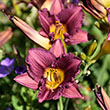
Ruffled purple blooms with yellow throats. Rebloomer. USDA 3-9
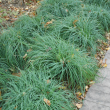
Height: 8 inches
Spread: 12 inches
Sunlight: partial shade, full shade
Hardiness Zone: 3a
Other Names: Oak Sedge
Description:
This shade loving native sedge features soft, arching semi-evergreen foliage; excellent in rock gardens, containers, or as a groundcover; prefers part shade and dry to medium moisture; tough and adaptable
Ornamental Features:
Pennsylvania Sedge is primarily valued in the garden for its cascading habit of growth. Its grassy leaves remain forest green in color throughout the season.
Landscape Attributes:
Pennsylvania Sedge is an herbaceous perennial grass with a shapely form and gracefully arching stems. It brings an extremely fine and delicate texture to the garden composition and should be used to full effect.
This is a relatively low maintenance plant, and is best cleaned up in early spring before it resumes active growth for the season. It has no significant negative characteristics.
Pennsylvania Sedge is recommended for the following landscape applications:
- Mass Planting
- Rock/Alpine Gardens
- Border Edging
- General Garden Use
- Groundcover
- Container Planting
- Planting & Growing
Pennsylvania Sedge will grow to be about 8 inches tall at maturity, with a spread of 12 inches. Its foliage tends to remain low and dense right to the ground. It grows at a slow rate, and under ideal conditions can be expected to live for approximately 10 years. As an herbaceous perennial, this plant will usually die back to the crown each winter, and will regrow from the base each spring. Be careful not to disturb the crown in late winter when it may not be readily seen!
This plant does best in partial shade to shade. It prefers to grow in average to dry locations, and dislikes excessive moisture. It is not particular as to soil type or pH. It is somewhat tolerant of urban pollution. Consider applying a thick mulch around the root zone in both summer and winter to conserve soil moisture and protect it in exposed locations or colder microclimates. This species is native to parts of North America. It can be propagated by division.
Pennsylvania Sedge is a fine choice for the garden, but it is also a good selection for planting in outdoor pots and containers. It is often used as a 'filler' in the 'spiller-thriller-filler' container combination, providing the canvas against which the thriller plants stand out. Note that when growing plants in outdoor containers and baskets, they may require more frequent waterings than they would in the yard or garden.
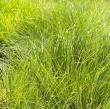
Height: 6 inches
Spread: 18 inches
Sunlight: partial shade full shade
Hardiness Zone: 3a
Description:
A weeping, perennial native sedge that forms graceful, mounded tufts of very fine textured, deep green, threadlike foliage; thrives in dry to mesic woods and does best with some shade; perfect for massing, slopes, or as a shade groundcover
Ornamental Features:
Appalachian Sedge is primarily valued in the garden for its cascading habit of growth. Its attractive threadlike leaves remain forest green in color throughout the season.
Landscape Attributes:
Appalachian Sedge is an herbaceous perennial grass with a shapely form and gracefully arching stems. It brings an extremely fine and delicate texture to the garden composition and should be used to full effect.
This is a relatively low maintenance plant, and is best cleaned up in early spring before it resumes active growth for the season. It has no significant negative characteristics.
Appalachian Sedge is recommended for the following landscape applications:
- Mass Planting
- Rock/Alpine Gardens
- Border Edging
- Groundcover
- Naturalizing And Woodland Gardens
- Container Planting
Planting & Growing:
Appalachian Sedge will grow to be only 6 inches tall at maturity, with a spread of 18 inches. Its foliage tends to remain low and dense right to the ground. It grows at a medium rate, and under ideal conditions can be expected to live for approximately 10 years. As an herbaceous perennial, this plant will usually die back to the crown each winter, and will regrow from the base each spring. Be careful not to disturb the crown in late winter when it may not be readily seen!
This plant does best in partial shade to shade. It prefers to grow in average to dry locations, and dislikes excessive moisture. It is considered to be drought-tolerant, and thus makes an ideal choice for a low-water garden or xeriscape application. This plant should not require much in the way of fertilizing once established, although it may appreciate a shot of general-purpose fertilizer from time to time early in the growing season. It is not particular as to soil type or pH. It is somewhat tolerant of urban pollution. This species is native to parts of North America. It can be propagated by division.
Appalachian Sedge is a fine choice for the garden, but it is also a good selection for planting in outdoor pots and containers. It is often used as a 'filler' in the 'spiller-thriller-filler' container combination, providing a canvas of foliage against which the thriller plants stand out. Note that when growing plants in outdoor containers and baskets, they may require more frequent waterings than they would in the yard or garden.
168 found, showing page 4 of 12













